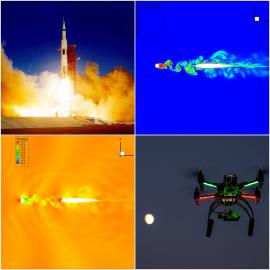
BS: Aeronautics and Astronautics
The New Undergraduate Program in Aeronautics and Astronautics offers students the opportunity to learn engineering principles through a project-based curriculum.
The objective of the undergraduate program in Aeronautics and Astronautics is to provide students with the fundamental principles and techniques necessary for success and leadership in the conception, design, implementation, and operation of aerospace and related engineering systems. Courses in the major introduce students to engineering principles through a project-based curriculum. Students learn to apply this fundamental knowledge to conduct laboratory experiments and aerospace system design problems. Courses in the major include engineering fundamentals, mathematics, and the sciences, as well as in-depth courses in aeronautics and astronautics, dynamics and control, mechanics of materials, and fluids engineering. Taking into account the unique location of Stanford at the heart of the Silicon Valley and modern trends in aerospace engineering, the major introduces concepts of autonomy, embedded programming, and system-level analysis and design as core disciplines in the curriculum -- this represents a radical departure from traditional curricula in aerospace engineering at peer institutions. The major prepares students for careers in aircraft and spacecraft engineering, space exploration, air- and space-based telecommunication industries, autonomous systems, robotics, commercial space transportation, teaching, research, military service, and many related technology-intensive fields.
Aeronautics and Astronautics Undergraduate Program Sheet
Future Course offerings
|
Course |
Description |
Year offered |
|
AA100 |
Introduction to Aeronautics and Astronautics *Understand the range of careers, challenges, and impact that is part of aerospace engineering. * Become aware of new design ideas for future aircraft and space vehicles, now being developed by large global aerospace companies and Silicon Valley start-ups. |
2017-18 |
|
AA101 |
Introduction to Aero Fluid Mechanics |
2018-19 |
|
AA141 |
Atmospheric Flight *Fluid flow with emphasis on aerodynamic principles. * Introduce students to the frontiers of aeronautical research and prepare them to lead others in the solution of future challenges. * Inspire rigorous experimental design, data analysis, critical thinking, and thoughtful communication and debate. |
2017-18 |
|
AA131 |
Space Flight * Critical thinking concerning the physics of spacecraft trajectories. * Ensure that students gain experience with software tools such as STK and Matlab *Ensure that students have a strong understanding of the physics of spacecraft trajectories and their applications |
2018-19 |
|
AA171 |
Autonomous Systems * Introduce students to the basic principles of autonomy, from perception, to decision making and learning. * Learn how to devise novel algorithms for the operation of increasingly sophisticated autonomous systems. * Implement algorithms on the Robot Operating System for real-world deployments. |
2019-20 |
|
|
|
|
|
AA102 |
Applied Aerodynamics * Introduce wide range of natural and human-made systems that depend on interactions with the air. * Explore the principles behind these phenomena, connecting complex features with underlying physics.
|
2018-19 |
|
AA103 |
Air and Space Propulsion * Introduce students to the wide variety of systems that produce power and thrust for air and space travel. * Teach students the physics that underlies propulsion systems including air breathing, chemical, electric, and plasma, nuclear and light-based propulsion.
|
2018-19 |
|
AA111 |
Aerospace Computational Engineering * To ensure that students have a strong understanding of the principles of fluid flow computation including incompressible and compressible flow, potential flow, viscous flows and shock waves.
|
2019-20 |
|
AA175 |
Embedded Programming * Introduce embedded microcontroller architectures and the C programming language.
|
2019-20 |
|
|
|
|
|
AA135 |
Introduction to Space Policy * To ensure that students understand the complexity surrounding multi-national space missions. * To promote communication and thoughtful debate concerning space policy. * To expose the student to policy and the resulting decisions that have shaped our space program. |
2018-19 |
|
AA151 |
Lightweight Structures * Analyze the stress-strain behavior of thin-walled structures. * Predict the strength and failure of lightweight structures and materials. * Connect theoretical structural principles to real-world scenarios through case study analysis of airframes, high-altitude balloons and solar sails. |
2018-19 |
|
AA172 |
Guidance & Navigation * Teach the fundamentals of earth navigation from the discovery of the compass to satellite navigation to cold atom inertial technologies. * Discuss the cyber safety of transportation and navigation. * Predict the future of navigation including cold atom inertial navigation and other embryonic technologies. |
2019-20 |
|
AA173 |
Flight Mechanics & Controls * Introduce students to the fundamentals of the mechanics of flight. * Provide students with a solid foundation in the mathematical and computer tools necessary to analyze and design complex aerodynamic systems. |
2019-20 |
|
AA 199 |
Independent Student in Aero/Astro |
2019-20 |
|
|
|
|
|
Course |
Description |
Year offered |
|
AA 149
|
Introduction to Flying/Piloting * Through the use of simulators and hands-on exposure to systems used by pilots, this course provides a connection with the products of aerospace design. The class will illustrate skills required of pilots in the past and those that may be important for future flight systems.
|
2018-19 |
Aero Astro Capstone Requirement:
|
Course |
Description |
Year offered |
|
AA 123A&B |
Air Capstone * To expose the students to the practical design of aircraft subsystems. * To expose the students to the integration of multiple components into a system. |
2019-20 |
|
AA 124 A&B |
Space Capstone * To expose the students to the practical design of spacecraft subsystems. * To expose the students to the practical design of rockets. * To engage the students in teamwork to engineer subsystems with emphasis on practical applications during the life cycle of a satellite/rocket project. |
2019-20 |



